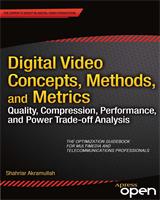
Digital Video Concepts, Methods, and Metrics
- Length: 368 pages
- Edition: 2014
- Language: English
- Publisher: Apress
- Publication Date: 2015-01-26
- ISBN-10: 1430267143
- ISBN-13: 9781430267140
- Sales Rank: #14748398 (See Top 100 Books)
Digital Video Concepts, Methods, and Metrics: Quality, Compression, Performance, and Power Trade-off Analysis
Digital Video Concepts, Methods, and Metrics: Quality, Compression, Performance, and Power Trade-off Analysis is a concise reference for professionals in a wide range of applications and vocations. It focuses on giving the reader mastery over the concepts, methods and metrics of digital video coding, so that readers have sufficient understanding to choose and tune coding parameters for optimum results that would suit their particular needs for quality, compression, speed and power.
The practical aspects are many: Uploading video to the Internet is only the beginning of a trend where a consumer controls video quality and speed by trading off various other factors. Open source and proprietary applications such as video e-mail, private party content generation, editing and archiving, and cloud asset management would give further control to the end-user.
Digital video is frequently compressed and coded for easier storage and transmission. This process involves visual quality loss due to typical data compression techniques and requires use of high performance computing systems. A careful balance between the amount of compression, the visual quality loss and the coding speed is necessary to keep the total system cost down, while delivering a good user experience for various video applications. At the same time, power consumption optimizations are also essential to get the job done on inexpensive consumer platforms.
Trade-offs can be made among these factors, and relevant considerations are particularly important in resource-constrained low power devices. To better understand the trade-offs this book discusses a comprehensive set of engineering principles, strategies, methods and metrics. It also exposes readers to approaches on how to differentiate and rank video coding solutions.
Table of Contents
Chapter 1: Introduction
Chapter 2: Digital Video Compression Techniques
Chapter 3: Video Coding Standards
Chapter 4: Video Quality Metrics
Chapter 5: Video Coding Performance
Chapter 6: Power Consumption by Video Applications
Chapter 7: Video Application Power Consumption on Low-Power Platforms
Chapter 8: Performance, Power, and Quality Tradeoff Analysis
Chapter 9: Conclusion







